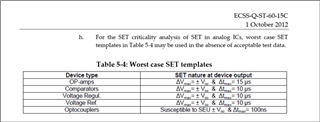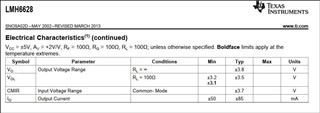Other Parts Discussed in Thread: LMH6628,
Hi,
we use the LMH6628WGFQMLV (5962F0254501VZA) for a space project as video input buffer. Actually we do a radiation analysis and have some troubles with the LMH6628.
In general there is not provided any documentation concerning SEEs (Single Event Effects) by TI.
For the analysis we have to use a worst case transient for SETs according to ECSS-Q-ST-60-15C (if there is no given measurement data from the supplier):

We supply the LMH6628 with -2.5V and +6.8V. This would result into a transient (±VCC) with -2.5V to +6.8V with 15us pulse duration.
We are now wondering if the LMH6628 is able to drive the output pins with VCC. According to datasheet (as we see) the output has to stay 1.2V away from its supply rails.
From SNOSAQ1B –DECEMBER 2010–REVISED MAY 2013



Q1: Is the assumption correct, that in case of a SET the output of the LMH6628 is limited to max. VCC-1.2V? Or more general: the output of the LMH6628 is under all conditions limited to a max. voltage of VCC-1.2V (by the internal circuit)?
Q2: Regarding Figure 25 from SNOSAQ1B, is it possible to interpolate the curve for higher loads (e.g. 1kΩ or 2kΩ)? It looks like there is only a small increase for loads greater than 100Ω.
Q3: Regarding the extract from SNOSA02D (industrial grade datasheet): The values differ slightly from the data given in SNOSAQ1B. Is there a real difference between the die of industrial grad and space grade? Or is the information given in the industrial datasheet more generalized for the table of parameters? Is it possible to give a RL=∞ for the space grade LMH6628?
With the answers of the above mentioned questions we would be able to adjust our supply levels (lower). So we would be able to still fit the functional input / output range and in case of a SET to drive the lowest transient as possible and to save our subsequent circuit.
Thank you.
Best regards, Alessandro

